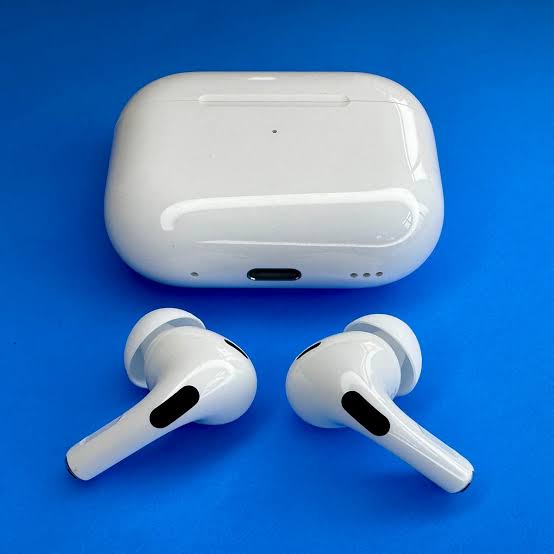Apple AirPods represent a breakthrough in personal audio technology, designed with precision to provide a seamless listening experience. Initially launched in 2016, Apple’s wireless earbuds have redefined how people consume audio on the go, pioneering features that have made them one of the most recognizable products in the wireless audio market.
Built with advanced technology and designed to integrate effortlessly with the Apple ecosystem, AirPods go beyond traditional headphones to provide a highly versatile and user-friendly device.
One of the standout features of AirPods is their true wireless design, eliminating the need for cables or connectors. Each earbud functions independently yet synchronizes perfectly for an immersive audio experience.
Apple’s design focuses on ergonomics and simplicity, creating a lightweight product that fits comfortably in the ear and can be worn for long periods without causing discomfort. The sleek, minimalist appearance of AirPods aligns with Apple’s aesthetic principles, making them not only a practical audio solution but also a fashion statement.
A central component of the AirPods’ capabilities is the custom-designed Apple H1 or W1 chip, depending on the model. These chips are responsible for the AirPods’ impressive performance, including fast and stable connections, efficient power consumption, and low-latency wireless audio transmission.
For instance, the H1 chip in the AirPods Pro and AirPods (2nd generation) allows for faster connections and facilitates switching between devices seamlessly.
With this technology, AirPods are compatible with any Bluetooth-enabled device, but they perform exceptionally well within the Apple ecosystem, where they connect automatically to iPhones, iPads, Macs, and even Apple Watches, enhancing the ease of use.
The intuitive setup process is another key feature of AirPods. When users first open the AirPods near an iPhone, a simple pop-up appears, guiding them through the connection process.
This feature removes the complexity often associated with pairing Bluetooth devices, making it an effortless experience for Apple users. Once connected, AirPods automatically sync across all devices linked to the user’s iCloud account, allowing seamless switching between devices.
This functionality is particularly useful for those using multiple Apple devices, such as transitioning from listening to music on an iPhone to taking a call on an iPad or Mac.
The audio quality of AirPods is another significant advantage, with each model offering high-fidelity sound designed to suit a range of listening needs. Apple has incorporated Adaptive EQ, which automatically adjusts frequencies to match the shape of the user’s ear, delivering a balanced sound profile.
The AirPods Pro, in particular, are equipped with Active Noise Cancellation (ANC) and Transparency Mode. ANC utilizes outward- and inward-facing microphones to block external sounds, creating an immersive audio experience.
Transparency Mode, on the other hand, allows users to hear their surroundings without removing the AirPods, which is particularly useful for staying aware of the environment while commuting or engaging in outdoor activities.
These features enable a personalized listening experience that can be easily adapted to different situations and preferences. Battery life is a crucial factor in wireless audio devices, and Apple has optimized the AirPods to offer impressive longevity.
With a single charge, AirPods provide up to five hours of listening time or up to three hours of talk time, depending on the model. The charging case adds additional charges, extending the total battery life significantly.
The AirPods Pro, for instance, offer more than 24 hours of listening time with multiple charges from the case. Additionally, the AirPods’ charging case supports wireless charging, and some models are compatible with Apple’s MagSafe technology, enhancing convenience by allowing users to charge without the need for cables.
Siri, Apple’s voice assistant, is integrated into AirPods, enabling hands-free control for various functions. By simply saying “Hey Siri,” users can play music, adjust volume, check messages, and perform other tasks without having to use their device directly.
This feature makes AirPods highly convenient, allowing for an entirely hands-free experience that aligns with Apple’s focus on accessibility and ease of use. Siri integration is particularly helpful during activities where hands are occupied, such as exercising or driving, where interacting with a device might be impractical or unsafe.
One of the most innovative aspects of the AirPods Pro is the spatial audio capability, which provides a theater-like experience by creating a three-dimensional audio space around the listener. Spatial audio uses dynamic head tracking to adjust the sound field as the user moves, making it seem as if audio is coming from various directions.
This feature enhances the experience of watching videos or listening to compatible audio content by delivering an immersive sound experience that replicates surround sound systems.
Spatial audio is compatible with select streaming services and works seamlessly on Apple devices, reflecting Apple’s commitment to delivering high-quality audio experiences. AirPods also include intuitive touch controls that allow users to manage music, calls, and more with simple taps or presses.
These controls vary slightly depending on the model; for example, AirPods Pro users can switch between Active Noise Cancellation and Transparency Mode with a press on the stem.
These controls are customizable, allowing users to assign specific functions to each earbud, providing a level of personalization to suit different preferences and habits.
This design element underscores Apple’s emphasis on user-centric functionality, ensuring that essential controls are always within reach. The AirPods’ functionality is further enhanced through the integration with the Apple Find My app.
If a user misplaces their AirPods, they can locate them through the app, which shows the last known location and can play a sound on the earbuds to help locate them. This feature provides added security and peace of mind, as it reduces the likelihood of permanently losing such a valuable item.
In addition to their core functionalities, AirPods are constantly improved through software updates, which provide users with access to new features and optimizations.
Apple’s commitment to regular updates ensures that AirPods remain relevant and continue to offer enhanced performance and capabilities over time. These updates contribute to the longevity of the product, allowing it to adapt to evolving user needs and technology trends.
Read Also: A Guide to Amazon Jobs: How to Apply and What to Expect
The Key Features of Apple AirPods

1. True Wireless Design: Apple AirPods lead the industry in wireless design, featuring a truly wireless experience that eliminates the need for cables. Each earbud functions independently, ensuring freedom of movement and a tangle-free experience. This design is both sleek and highly functional, fitting comfortably in the ear for extended wear.
The minimalistic and compact design aligns with Apple’s aesthetic standards, making AirPods a blend of technology and style. This wireless structure makes them convenient for on-the-go use, ideal for everything from workouts to business calls.
2. Custom-Built H1 and W1 Chips: The power of Apple AirPods lies in their custom-built H1 (AirPods Pro and AirPods 2nd and 3rd generation) and W1 (AirPods 1st generation) chips. These chips provide an incredibly fast and stable connection, allowing users to switch seamlessly between Apple devices without delay.
Additionally, the H1 chip supports lower latency, ensuring that the sound is in perfect sync with videos and games, offering a superior listening experience. The chips also contribute to power efficiency, extending the battery life so users can enjoy music or calls for longer without frequent recharging.
3. Automatic Setup and Device Switching: Apple AirPods offer one of the most effortless setup processes in the industry. As soon as you open the AirPods case near an iPhone or other Apple device, a pop-up appears to guide you through the quick pairing process.
Once paired, the AirPods automatically sync across all devices linked to your iCloud account, enabling you to switch seamlessly between your iPhone, iPad, Mac, and Apple Watch. This automatic setup and switching feature make AirPods a perfect addition to the Apple ecosystem, optimizing ease of use.
4. High-Quality Audio Output: Apple AirPods are known for delivering superior sound quality. The earbuds are engineered to provide balanced sound, with crisp highs and rich bass that enhance music, podcasts, and calls.
With Adaptive EQ in certain models, AirPods automatically adjust frequencies based on the shape of your ear, providing a personalized listening experience. Whether it’s listening to high-energy tracks or tuning into a conference call, the sound quality of Apple AirPods makes them stand out in the wireless audio market.
5. Active Noise Cancellation and Transparency Mode: Apple AirPods Pro offer Active Noise Cancellation (ANC), a feature that uses external and internal microphones to block out unwanted background noise, creating an immersive listening environment.
ANC is particularly useful in noisy environments, such as during commutes or in busy public spaces, where it allows you to focus on your audio content without distraction.
Transparency Mode, also available in AirPods Pro, enables users to hear their surroundings while still listening to audio, which is beneficial in situations where situational awareness is necessary, like while walking on a busy street.
6. Long-Lasting Battery Life and Wireless Charging Case: Battery life is a key strength of Apple AirPods, with each model designed to provide hours of listening and talk time on a single charge. Depending on the model, AirPods can provide up to five hours of listening time, with additional charges provided by the case extending total usage up to 24 hours or more.
For convenience, AirPods cases support wireless charging, and some are compatible with Apple’s MagSafe technology, allowing you to charge effortlessly by placing them on a compatible charging pad.
7. Hands-Free Siri Activation: Apple AirPods offer hands-free access to Siri, Apple’s voice assistant, allowing users to perform a variety of tasks without reaching for their device. By simply saying “Hey Siri,” users can ask Siri to play music, adjust volume, check messages, or provide directions.
Hands-free Siri activation enhances the convenience of AirPods, especially for users who are busy or on the move, as it allows them to control their devices without interrupting what they are doing.
8. Spatial Audio with Dynamic Head Tracking: Apple AirPods Pro and AirPods Max bring an immersive experience to the table with spatial audio. This feature simulates surround sound, creating a 3D audio environment that makes it seem as if sound is coming from different directions around you.
Dynamic head tracking adjusts the audio based on your head movements, providing a cinematic audio experience. Spatial audio is particularly effective when watching movies or TV shows on compatible apps, adding depth and realism to the audio content.
9. Intuitive Touch Controls and Customization: Apple AirPods are designed with user-friendly touch controls that allow you to manage music, calls, and other functions with simple gestures. On standard AirPods, users can double-tap to play or skip tracks.
On AirPods Pro, a pressure-sensitive stem allows users to toggle between noise-canceling modes, play or pause music, and activate Siri. These controls are customizable, allowing you to assign specific actions to each earbud, which enhances usability and makes it easy to access essential functions quickly.
10. Compatibility with Apple Find My App: Losing an AirPod is a concern for many users, but Apple has addressed this with Find My integration. Apple AirPods can be located through the Find My app, which shows their last known location and allows users to play a sound to help locate them if they are nearby. This feature provides peace of mind, as users can easily track their AirPods if misplaced, reducing the risk of loss.
11. Personalized Fit and Comfort: Apple AirPods are engineered for a comfortable and secure fit, suitable for long-term wear. The AirPods Pro come with multiple ear tip sizes, allowing users to choose the best fit for their ears, enhancing noise isolation and comfort.
This personalized fit is a significant advantage for those who wear them for extended periods, whether for listening to music, engaging in calls, or working out.
12. Constant Updates and New Features: Apple regularly releases firmware updates for AirPods, adding new features, improvements, and bug fixes over time. These updates ensure that Apple AirPods remain up-to-date with the latest technological advancements and user needs.
As part of Apple’s commitment to customer satisfaction, these updates contribute to the longevity and relevance of the product, keeping it fresh and optimized for the best user experience.
13. Seamless Integration with Apple Ecosystem: Apple AirPods are an integral part of the Apple ecosystem, working effortlessly with iPhones, iPads, Macs, and Apple Watches. This deep integration enables seamless transitions between devices, enhancing the convenience and functionality of AirPods for Apple users.
This ecosystem compatibility is one of the primary reasons why AirPods are favored among those invested in Apple products, as it enables a connected experience across multiple devices, elevating the usability and value of Apple AirPods.
Read Also: Amazon Flex: The Ultimate Guide to Earning Fast and Efficiently
How to Set Up and Maximize Your Apple AirPods

Setting up and maximizing the potential of your Apple AirPods is a straightforward process that allows users to fully benefit from these highly advanced, wireless earbuds. Apple AirPods are designed for seamless integration with various Apple devices, ensuring a top-tier audio experience that is easy to configure and optimize for specific needs.
1. Initial Setup for Apple AirPods: When first setting up your Apple AirPods, ensure that your device’s Bluetooth is enabled. This connectivity is the fundamental requirement for Apple AirPods to function. Once Bluetooth is activated, bring the Apple AirPods case close to the device, and open the lid. For most Apple devices, a prompt will automatically appear on the screen, inviting you to connect. Follow the on-screen instructions, which involve a simple one-tap setup that syncs your AirPods to the device. For iOS 13 and later, this setup will also sync your Apple AirPods across all devices linked to your iCloud account, including iPads, Macs, and Apple Watches. This process provides a seamless transition when switching between Apple devices.
In cases where the setup prompt does not appear, manually access Bluetooth settings on your device, locate your Apple AirPods under available devices, and select them to initiate the connection. This process should be repeated on any non-Apple device you wish to pair, ensuring compatibility and ease of use.
2. Configuring Sound Settings: After successfully pairing your Apple AirPods, you can configure their sound settings to match your listening preferences. On Apple devices, navigate to the Bluetooth settings, select your Apple AirPods, and customize features such as noise cancellation, transparency mode, and spatial audio, if available. For Apple AirPods Pro and AirPods Max, noise cancellation can be activated to block ambient sounds, making them ideal for use in noisy environments. Transparency mode, alternatively, allows some ambient sound to filter through, a useful feature when maintaining awareness of your surroundings is essential.
Spatial audio, exclusive to newer Apple AirPods models, provides an immersive sound experience that adapts to your head movements, simulating a surround sound environment. By toggling spatial audio on or off within your AirPods settings, you can achieve a personalized listening experience tailored to different types of audio content, from movies to music.
3. Activating Siri and Voice Controls: Apple AirPods offer hands-free access to Siri, Apple’s virtual assistant, enabling a range of tasks without requiring physical interaction. To enable “Hey Siri” on compatible Apple AirPods, navigate to Siri settings on your iPhone or iPad and ensure voice activation is enabled. Once activated, simply say “Hey Siri” to control music playback, adjust volume, make calls, send messages, or receive information. This hands-free functionality makes Apple AirPods highly practical for use while commuting, exercising, or engaging in tasks where accessing your device is inconvenient.
You may also manually invoke Siri by pressing and holding the force sensor on your Apple AirPods Pro or tapping the AirPods twice on earlier models. By configuring these settings, you ensure that voice control is optimized to suit your preferences, making your Apple AirPods a truly hands-free experience.
4. Customizing Touch and Tap Controls: Apple AirPods provide an array of control options through touch and tap gestures, which can be customized according to your needs. For instance, double-tapping an AirPod on earlier models lets you play, pause, or skip tracks, while Apple AirPods Pro feature force sensors for even greater control. In the Bluetooth settings of your paired device, you can assign specific functions to each earbud, allowing for complete control over music playback, noise-cancellation modes, and Siri activation.
For Apple AirPods Pro, the force sensor allows you to toggle between noise cancellation and transparency modes, a particularly useful feature for quickly adapting to different listening environments. By adjusting these touch and tap controls, users can personalize their Apple AirPods for a tailored and responsive audio experience.
5. Managing Battery Life and Charging Efficiently: Apple AirPods are known for their impressive battery life, though maximizing this feature requires proper management. Each Apple AirPods model provides a different amount of listening and talk time, with additional power stored in the charging case. To check battery levels, hold your Apple AirPods case near your iPhone or add the battery widget to your iOS device’s home screen, which will display real-time battery status for each AirPod and the charging case.
Charging Apple AirPods is simple, as the charging case itself can be charged either wirelessly (if using a wireless-compatible case) or via a Lightning cable. For users with MagSafe-compatible cases, simply place the case on a MagSafe charger for wireless charging. Recharging the case frequently ensures that your Apple AirPods are always ready for use, while avoiding full discharge cycles can also help maintain battery health over time.
6. Utilizing the Apple Find My App for Tracking: The Apple Find My app offers an essential tool for locating lost Apple AirPods. This feature allows users to track the last known location of their AirPods on a map or play a sound to locate them if they are nearby. In the event that an AirPod or case goes missing, open the Find My app on an Apple device and select your Apple AirPods under devices. By using this feature, users can quickly recover misplaced AirPods and avoid potential loss.
7. Firmware Updates for Enhanced Performance: Apple frequently releases firmware updates for Apple AirPods, designed to improve performance, address bugs, and occasionally introduce new features. Firmware updates are applied automatically when the Apple AirPods are connected to an iPhone and placed in their case with a sufficient battery charge. Regular updates help maintain the best performance for Apple AirPods, so it is advisable to occasionally check for updates by navigating to the Bluetooth settings and selecting your AirPods.
8. Maximizing Apple AirPods for Specific Activities: Apple AirPods are versatile and well-suited to various activities, from work and study to exercise. For those using Apple AirPods during workouts, the lightweight and secure fit of newer models ensures that they stay in place during physical activity. Apple AirPods Pro, in particular, offer a customizable fit with three sizes of silicone tips, ensuring stability even during rigorous exercise. Noise cancellation on these models also allows users to focus on their workout music without external distractions.
For business or professional use, Apple AirPods provide clear call quality, with beamforming microphones that focus on your voice while reducing ambient noise. This feature is especially useful for remote work and video calls, where audio clarity is essential. By leveraging these specific features, users can maximize the potential of Apple AirPods across a variety of use cases.
9. Caring for and Maintaining Apple AirPods: Proper care and maintenance contribute significantly to the longevity and performance of Apple AirPods. Regularly cleaning the earbuds and charging case with a dry, lint-free cloth prevents the buildup of dust and debris, which can affect sound quality and charging efficiency. Avoid exposing Apple AirPods to extreme temperatures or moisture, as this can impact their durability and functionality. By adhering to these maintenance practices, users can ensure that their Apple AirPods remain in optimal condition for extended use.
Frequently Asked Questions on Key Features of Apple AirPods You Should Know

1. What makes Apple AirPods different from other wireless earbuds?
Apple AirPods stand out due to their seamless integration with Apple devices, advanced features like automatic ear detection, spatial audio, and noise cancellation (available in specific models), along with hands-free Siri functionality. Their quick setup process and ability to switch between devices linked to an iCloud account also enhance user convenience.
2. What is the purpose of noise cancellation and transparency mode on Apple AirPods?
Noise cancellation on Apple AirPods Pro and AirPods Max reduces external sounds, creating a more immersive listening experience. Transparency mode, on the other hand, allows some external sounds to pass through, which is helpful for users who need to stay aware of their surroundings.
3. How does spatial audio work on Apple AirPods?
Spatial audio, available on recent Apple AirPods models, uses dynamic head-tracking to create a surround-sound experience. This feature provides an immersive audio effect by adjusting sound placement based on head movements, ideal for watching movies or using compatible apps.
4. Can I use Apple AirPods with non-Apple devices?
Yes, Apple AirPods are compatible with non-Apple devices via Bluetooth. However, certain Apple-exclusive features, like spatial audio, Siri functionality, and automatic switching between devices, may be limited or unavailable on non-Apple devices.
5. How long does the battery last on Apple AirPods?
Battery life varies by model but generally lasts up to 5 hours on a single charge for standard listening, with additional charges provided by the charging case. AirPods Pro offer up to 4.5 hours with active noise cancellation enabled. The charging case allows for extended use, providing multiple full charges.
6. What customization options are available for Apple AirPods controls?
Apple AirPods allow customization of tap or press gestures. Users can configure functions like play/pause, skip tracks, toggle noise cancellation modes, or activate Siri. These customizations can be adjusted in the Bluetooth settings on connected Apple devices.
7. How do I track lost Apple AirPods?
Apple AirPods can be tracked using the Find My app, which displays the last known location on a map. Users can also play a sound on the AirPods if they are nearby. This feature is invaluable for quickly locating misplaced AirPods, minimizing the risk of loss.
Read Also: Master of Business Administration (MBA) Online Degree
Do you have any questions, suggestions, or contributions? If so, please feel free to use the comment box below to share your thoughts. We also encourage you to kindly share this information with others who might benefit from it. Since we can’t reach everyone at once, we truly appreciate your help in spreading the word. Thank you so much for your support and for sharing!






